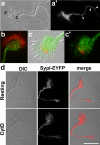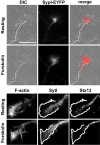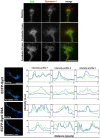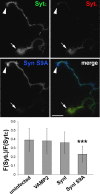Phosphorylation of synapsin I by cAMP-dependent protein kinase controls synaptic vesicle dynamics in developing neurons
- PMID: 16093379
- PMCID: PMC6725302
- DOI: 10.1523/JNEUROSCI.1573-05.2005
Phosphorylation of synapsin I by cAMP-dependent protein kinase controls synaptic vesicle dynamics in developing neurons
Abstract
In developing neurons, synaptic vesicles (SVs) undergo cycles of exo-endocytosis along isolated axons. However, it is currently unknown whether SV exocytosis is regulated before synaptogenesis. Here, we show that cAMP-dependent pathways affect SV distribution and recycling in the axonal growth cone and that these effects are mediated by the SV-associated phosphoprotein synapsin I. The presence of synapsin I on SVs is necessary for the correct localization of the vesicles in the central portion of the growth cone. Phosphorylation of synapsin I by cAMP-dependent protein kinase (protein kinase A) causes the dissociation of the protein from the SV membrane, allowing diffusion of the vesicles to the periphery of the growth cone and enhancing their rate of recycling. These results provide new clues as to the bases of the well known activity of synapsin I in synapse maturation and indicate that molecular mechanisms similar to those operating at mature nerve terminals are active in developing neurons to regulate the SV life cycle before synaptogenesis.
Figures









Similar articles
-
Protein kinase A-mediated synapsin I phosphorylation is a central modulator of Ca2+-dependent synaptic activity.J Neurosci. 2006 Nov 8;26(45):11670-81. doi: 10.1523/JNEUROSCI.3321-06.2006. J Neurosci. 2006. PMID: 17093089 Free PMC article.
-
Kainate induces mobilization of synaptic vesicles at the growth cone through the activation of protein kinase A.Cereb Cortex. 2013 Mar;23(3):531-41. doi: 10.1093/cercor/bhs026. Epub 2012 Mar 7. Cereb Cortex. 2013. PMID: 22402347
-
Tyrosine phosphorylation of synapsin I by Src regulates synaptic-vesicle trafficking.J Cell Sci. 2010 Jul 1;123(Pt 13):2256-65. doi: 10.1242/jcs.068445. Epub 2010 Jun 8. J Cell Sci. 2010. PMID: 20530578
-
How synapsin I may cluster synaptic vesicles.Semin Cell Dev Biol. 2011 Jun;22(4):393-9. doi: 10.1016/j.semcdb.2011.07.006. Epub 2011 Jul 21. Semin Cell Dev Biol. 2011. PMID: 21798362 Review.
-
The synapsin cycle: a view from the synaptic endocytic zone.J Neurosci Res. 2007 Sep;85(12):2648-56. doi: 10.1002/jnr.21176. J Neurosci Res. 2007. PMID: 17455288 Review.
Cited by
-
Epilepsy as a neurodevelopmental disorder.Front Psychiatry. 2012 Mar 19;3:19. doi: 10.3389/fpsyt.2012.00019. eCollection 2012. Front Psychiatry. 2012. PMID: 22457654 Free PMC article.
-
The TrkC-PTPσ complex governs synapse maturation and anxiogenic avoidance via synaptic protein phosphorylation.EMBO J. 2024 Nov;43(22):5690-5717. doi: 10.1038/s44318-024-00252-9. Epub 2024 Sep 27. EMBO J. 2024. PMID: 39333774 Free PMC article.
-
The role of synapsins in neuronal development.Cell Mol Life Sci. 2010 May;67(9):1383-96. doi: 10.1007/s00018-009-0227-8. Epub 2009 Dec 25. Cell Mol Life Sci. 2010. PMID: 20035364 Free PMC article. Review.
-
Synapsins contribute to the dynamic spatial organization of synaptic vesicles in an activity-dependent manner.J Neurosci. 2012 Aug 29;32(35):12214-27. doi: 10.1523/JNEUROSCI.1554-12.2012. J Neurosci. 2012. PMID: 22933803 Free PMC article.
-
Interferon-γ exposure of human iPSC-derived neurons alters major histocompatibility complex I and synapsin protein expression.Front Psychiatry. 2022 Sep 14;13:836217. doi: 10.3389/fpsyt.2022.836217. eCollection 2022. Front Psychiatry. 2022. PMID: 36186864 Free PMC article.
References
-
- Ahmari SE, Buchanan J, Smith SJ (2000) Assembly of presynaptic active zones from cytoplasmic transport packets. Nat Neurosci 3: 445-451. - PubMed
-
- Banker GA, Cowan WM (1977) Rat hippocampal neurons in dispersed cell culture. Brain Res 126: 397-442. - PubMed
-
- Chi P, Greengard P, Ryan TA (2001) Synapsin dispersion and reclustering during synaptic activity. Nat Neurosci 4: 1187-1193. - PubMed
Publication types
MeSH terms
Substances
Grants and funding
LinkOut - more resources
Full Text Sources
